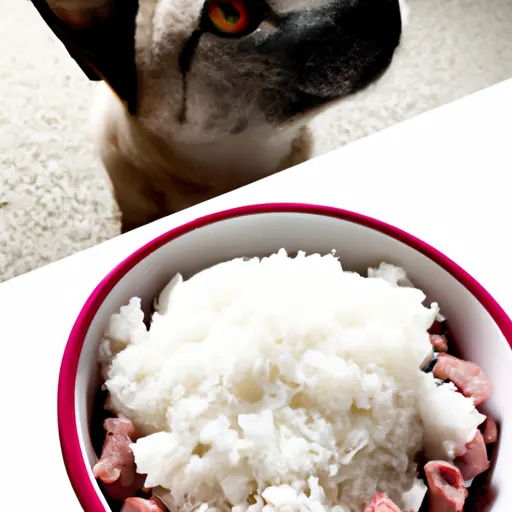This site is supported by our readers. We may earn a commission, at no cost to you, if you purchase through links.
We know that dogs are omnivores, and they enjoy a variety of different foods. But can dogs eat tuna and rice? Many pet owners often wonder whether this combination is safe for their furry family members.
In this article, we’ll explore the nutritional benefits of feeding your pup tuna and rice as well as discuss any potential risks associated with it. We’ll also provide tips on how to safely feed these two ingredients to your dog so you can make an informed decision about incorporating them into his or her diet plan.
Table Of Contents
Why Tuna is a Popular Dog Food

For those who prefer convenience, there are also delicious canned alternatives available that contain balanced amounts of protein and omega fatty acids essential for dogs’ health.
Moving on from here, let’s look into how nutritionally beneficial tuna and rice is for dogs.
Nutritional Benefits of Tuna and Rice for Dogs
We’re here to discuss the nutritional benefits of feeding your pup a combination of tuna and rice! Tuna is an excellent source of protein for dogs, while rice can provide essential carbohydrates.
Feeding your dog this combination in moderation can help meet their exercise needs as well as add variety to their diet. Preparing home cooked meals with tuna and rice also provides an opportunity to customize dishes for any food allergies or special dietary needs that may arise in certain breeds.
Additionally, monitoring the amount you feed each day ensures proper portion sizes are met without overfeeding, which could lead to unhealthy habits down the road.
Risks of Feeding Tuna and Rice to Dogs

Additionally, canned tuna often contains high levels of sodium which may not be ideal for some dogs’ diets. Finally, allergies and digestive issues could arise if a dog consumes too much fish or rice—especially if they have sensitivities or existing conditions related to digestion or food intake.
Mercury Levels in Tuna
We understand that the mercury levels in tuna can be a concern for pet owners, so we want to make sure you’re informed about the different types of tuna and how much is safe to feed your beloved companion.
Tuna sources should be checked for mercury testing before feeding it to your dog, and only Skipjack or Albacore varieties should be used. Cooking guidelines must also be followed when preparing fresh fish, as dogs may have allergies that need consideration.
Canned tuna typically contains high sodium levels, so look out for brands canned in spring water instead or drained thoroughly from oils like sunflower oil, which are considered safer options than brine- canned versions.
With these tips, you can make sure any treats given from tins will contribute towards your pup’s health rather than detriment their wellbeing. This smoothly transitions into our next section discussing Sodium Levels in Canned Tuna.
Sodium Levels in Canned Tuna
We want to make sure your pup stays healthy, so it’s important to understand the sodium levels in canned tuna before feeding it as a treat. Canned tuna can be an easy way for boosting immunity and adding protein and Omega-3 fatty acids to homemade recipes.
However, you should check labels carefully when choosing wild caught varieties of tuna or those packed in natural oils; these often have lower sodium levels than other types that are preserved with brine or saltwater solutions.
Feeding your dog too much high- sodium canned tuna can disrupt their balanced diet if they eat more than one tablespoon at a time.
That’s why we recommend sticking with fresh, cooked options whenever possible!
Allergies and Digestive Issues
We must be aware of any allergies or digestive issues our beloved companions may have when introducing tuna to their diet. If there’s an allergic reaction, a fish substitution like mackerel can be used instead.
It’s also important to test for food allergies and consult with a veterinarian if necessary before making changes in the dog’s diet.
Digestive health can also be impacted by adding new foods, so it’s important to consider the type of rice being fed along with tuna – brown rice varieties are usually better than white rice as they contain more fiber and nutrients.
Additionally, homemade recipes that mix cooked tuna with other ingredients like boiled vegetables should only include small amounts of oil or butter for flavor and texture but not salt, which could lead to health problems down the line.
How to Safely Feed Dogs Tuna and Rice
We are here to discuss the safe ways of feeding tuna and rice to dogs. Preparing tuna and rice for your pet is an important part of keeping them healthy, as well as understanding portion sizes and frequency when it comes to this combination.
There are also alternatives available if you’re looking for something different than just tuna and rice.
Preparing Tuna and Rice for Dogs
Let’s get cooking and prepare a tasty tuna and rice meal for our furry friends! Using different ingredients, we can create homemade recipes that are tailored to meet the nutritional needs of our pups.
To ensure food safety, it’s best to cook all ingredients before feeding them to your dog. When preparing meals at home, portion control should be taken into account as dogs have much smaller stomachs than humans do.
If you want an extra nutritious boost in the meal, adding some antioxidants will help support their immune system too! Feeding methods may vary depending on how picky your pup is, but make sure they don’t eat too quickly or else they might develop digestive issues.
Which leads us nicely onto discussing appropriate portion sizes and frequency of feeding for this tuna and rice dish.
Portion Sizes and Frequency of Feeding
We should feed our pup small, balanced portions of tuna and rice no more than once or twice a week – with an occasional teaspoon as a treat – to ensure their diet is nutritious and safe.
Preparing the tuna correctly is essential; there are types which contain high levels of mercury, such as Bluefin Tuna, so it’s important to check labels before feeding your pooch. Canned tuna can be fed in moderation but make sure to drain the liquid first – ideally opt for cans packed in spring water instead of brine as this contains less salt.
Rice alternatives like sweet potato or quinoa may also provide antioxidants while reducing digestive troubles that dogs may experience when eating grains such as wheat.
With careful consideration for portion sizes and frequency you can keep your pup healthy while providing them tasty treats from time- to- time!
Alternatives to Tuna and Rice
Let’s explore delicious alternatives to tuna and rice for our furry friends! Freezing tuna can be a great way to preserve the freshness of fish- based diets. Organic rice is also a nutritious option for dogs that need carbohydrates in their diet.
Grain- free food can provide an alternative source of protein, such as canned salmon which is rich in omega 3 fatty acids and has less mercury than other types of fish. Additionally, adding antioxidants into your pet’s meal plan may offer additional health benefits.
Fortunately, there are many options available that’ll help keep your pup happy and healthy – you just have to find what works best for them! To move on from this topic about alternatives let’s dive into portion sizes and frequency when it comes to feeding time with canine companions.
Frequently Asked Questions (FAQs)
How much tuna and rice should I feed my dog?
We understand that you may be asking how much tuna and rice to feed your dog, particularly in terms of raw or cooked diets. It’s important to note that homemade recipes shouldn’t contain either ingredient as a main part of the diet due to health risks posed by both tuna and rice.
However, if you’re adamant on feeding your pup these ingredients occasionally, it’s best to stick with skipjack or albacore tuna canned in spring water (be sure to drain any excess oil) for no more than one tablespoon per week.
Larger dogs can consume up to 2 tablespoons every other week. White fish or salmon provide better alternatives for omega-3 fatty acids.
As far as rice goes, opt for brown over white as it has higher nutritional value.
Are there any other types of fish I can feed my dog instead of tuna?
We know tuna is safe for dogs in small amounts, but if you’re looking to feed your pup something different, there are plenty of other fish options available.
Mackerel, sardines, salmon and tilapia are all good choices as they contain fewer mercury levels than tuna.
So don’t be afraid to mix it up with some variety – just make sure whatever you feed them is cooked properly beforehand!
Is it safe to feed tuna and rice to puppies?
We all want to give our puppies the best start in life, and that includes their diet. While tuna is a great source of protein and omega-3 fatty acids for dogs, it’s important to know if feeding them tuna and rice is safe.
Veterinary advice suggests that organic options are best when it comes to feeding your pup; however, canned tuna can be used occasionally as long as you look out for salt content or other additives like oil which may have an environmental impact.
There are also recipe variations available such as fresh cooked steak or skipjack varieties which provide balanced nutrition without mercury risks associated with some species of fish like bluefin tuna.
What are the benefits of feeding tuna and rice to my dog?
We understand that feeding your dog tuna and rice can be a great way to supplement their diet. Canned versus fresh tuna options are available, with the latter being more expensive but healthier due to lower mercury levels.
Rice varieties range from white or brown rice, both of which provide essential nutrients needed for canine health. Cost comparison between canned and fresh is important when making decisions about what type of food you will feed your pet; organic options may cost more but they offer additional nutritional benefits as well as peace- of- mind knowing it’s free from additives and preservatives.
Health supplements like omega 3 fatty acids found in fish such as skipjack tuna can help keep skin healthy while providing anti- inflammatory properties – all good news for our furry friends!
Can I feed my dog tuna and rice every day?
We can feed our dogs tuna and rice, but it shouldn’t be done on a regular basis. Tuna is rich in protein and omega-3 fatty acids, both of which are beneficial for your dog’s health. However, too much tuna can cause digestive issues due to the lack of other essential nutrients.
To ensure that your dog gets all the necessary vitamins and minerals they need to stay healthy while still enjoying a tasty treat from time to time, try mixing their food with small amounts of cooked white or pink salmon instead.
Additionally, always check with your veterinarian before making any changes in feeding patterns or introducing new foods. They will have tailored advice based off of specific dietary needs and habits for each individual pet.
Conclusion
We’ve established that tuna and rice can be fed to dogs in moderation. While it may provide protein and omega-3 fatty acids, it’s important to consider the risks of feeding tuna and rice to our furry friends.
Too much tuna can lead to mercury poisoning, while canned tuna is often high in sodium. If allergies or digestive issues occur, it’s important to switch to an alternative.
Feeding our dogs tuna and rice can be compared to taking a road trip. Just as we plan our journey, we need to plan our dogs’ meals and research the best options. With a bit of preparation and care, we can provide our furry friends with a nutritious and safe meal that will help them stay healthy and happy.






